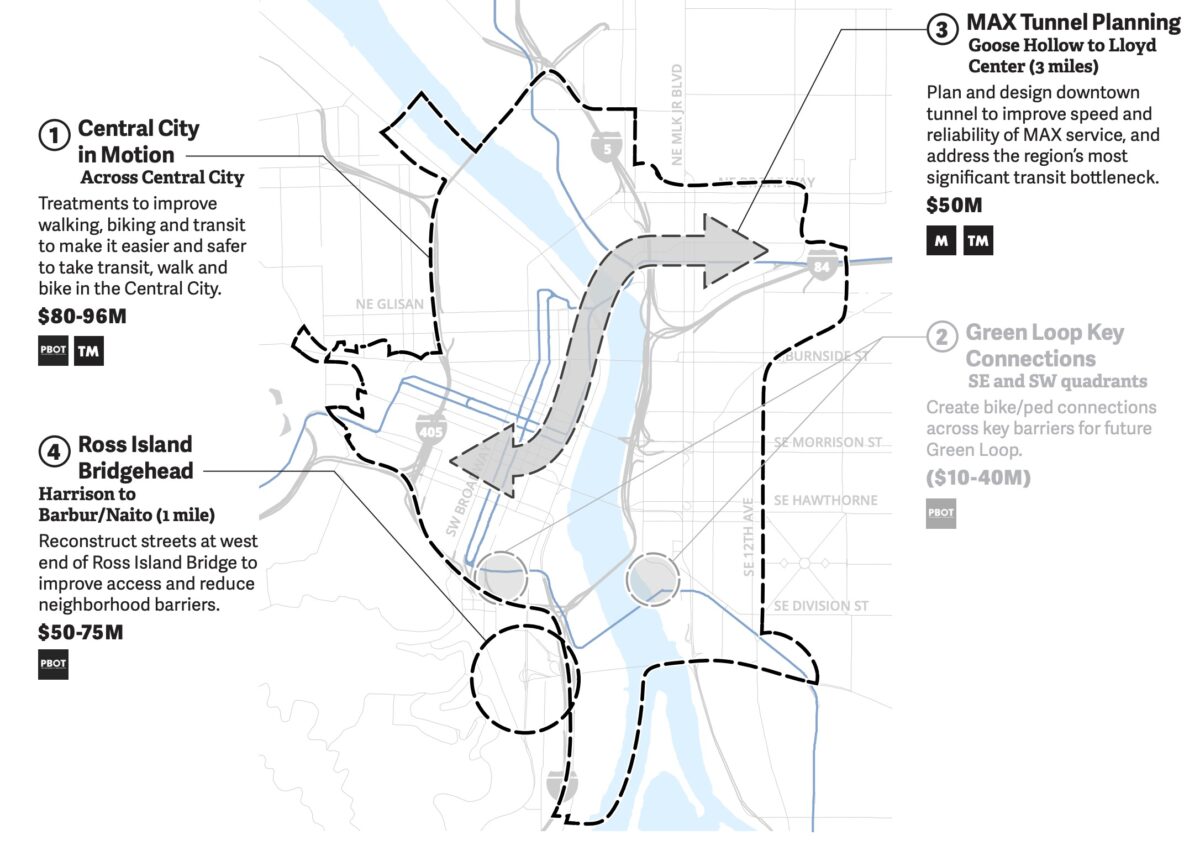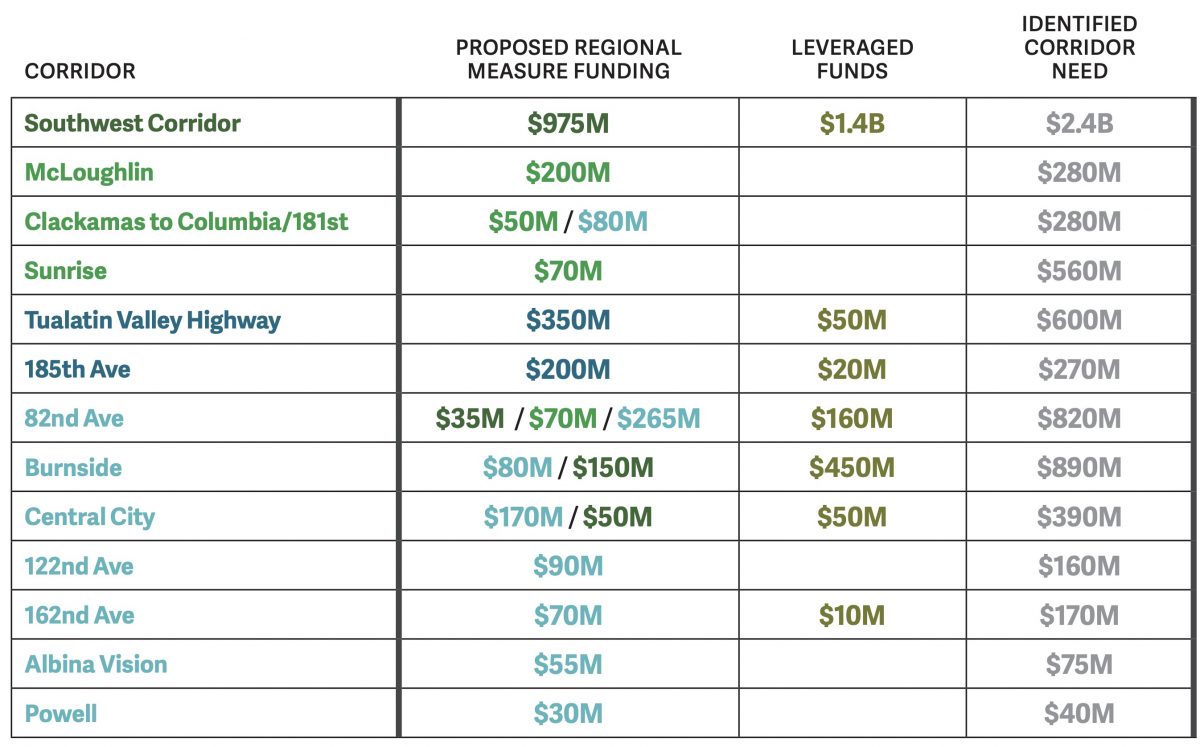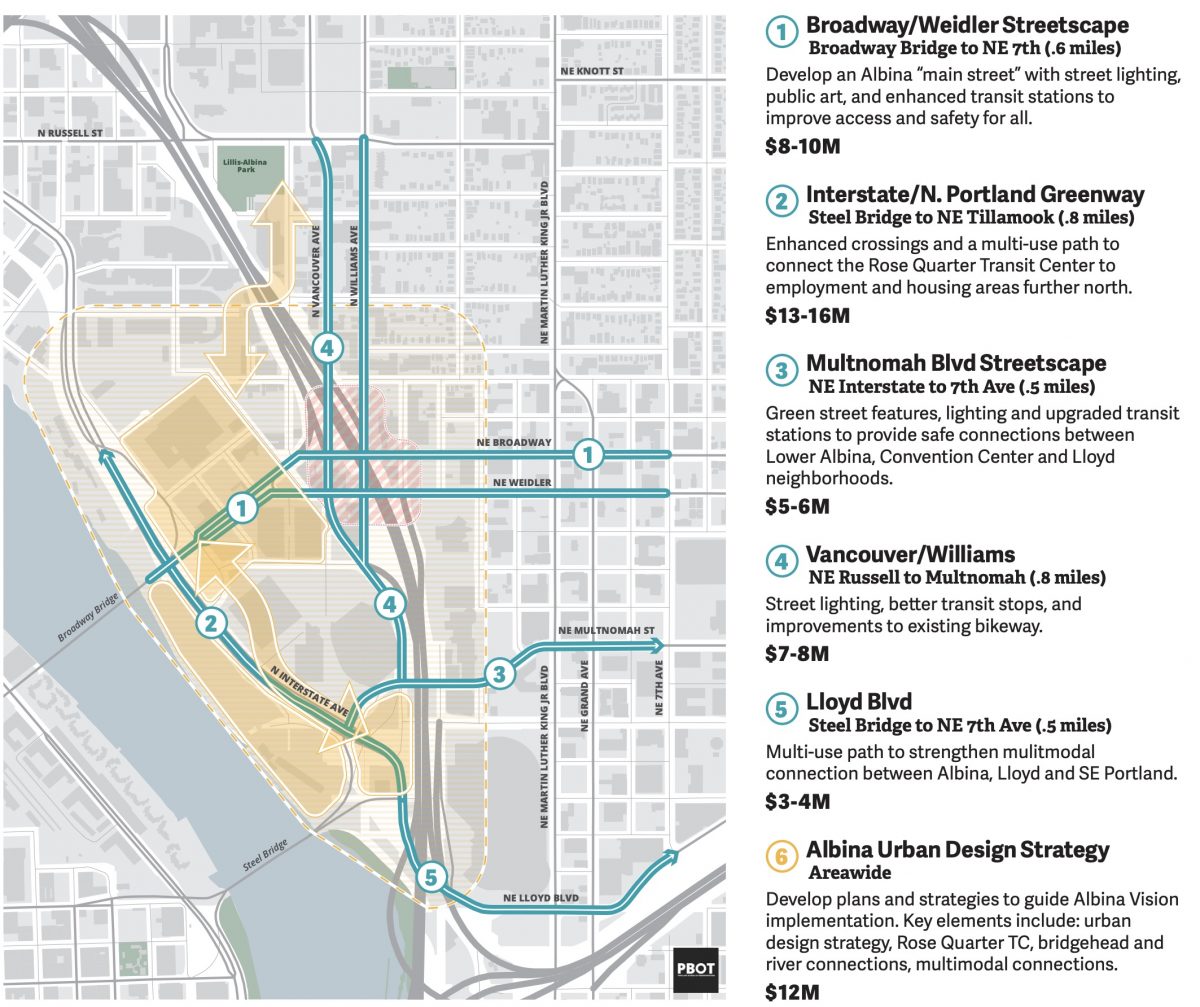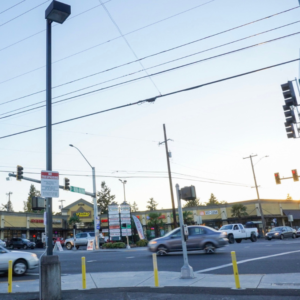Metro staff has given us the clearest picture yet on what they’d like to see funded if a new transportation spending measure passes on next November’s ballot. Yesterday they released a recommendation of 68 projects worth over $3.1 billion (PDF) that would be spent across Washington, Clackamas, and Multnomah counties.
Among the projects are major bus (and related) service enhancements on some of our region’s deadliest arterials including TV Highway, 82nd, and McLoughlin — all of which are owned and operated by the Oregon Department of Transportation, who’ve been stubbornly resistant to ceding power over them for years. In what appears to be a major coup, Metro has garnered ODOT’s approval for substantive changes. The investments would be a crucial step toward the long-sought jurisdictional transfer of 82nd Ave from ODOT to PBOT.
The projects are grouped within 13 corridors that were identified and prioritized after eight months of work by a 35-member task force and “local investment teams” from each county. Metro staff also spent six months working with a consultant (Kittelson & Associates, Inc) and partner agencies including the Oregon Department of Transportation (ODOT) and held a series of technical workshops to come up with the list. In addition to values like equity, safety, economic growth, congestion mitigation, and so on, Metro staff weighed things like project feasibility (a.k.a. is it “shovel ready”), whether or not something was in an existing plan, and whether it had existing funds that could be leveraged.
Metro says the $3.1 billion has the potential to leverage $2.1 billion for a total investment of $5.2 billion. This is considered just a starting point meant to address the most pressing needs of the regional transportation network.
The SW Corridor is the biggest ticket item at $975 million. Metro says those funds could be used to build out eight projects, including “continuous high quality sidewalks, protected bike lanes and crossings on Barbur between I-405 and the Barbur Transit Center.”
Of the nearly 70 projects recommended there are only a few that are solely focused on new roads or increasing capacity for drivers. One project, estimated to cost $40 to $54 million would build a new, 1.25 mile road to connect SE 172nd to 190th. The road would include sidewalks, bikeways and roundabout to “create a continuous Clackamas to Columbia corridor.” A Metro source says Clackamas County proposed this project with four driving lanes, but Metro’s recommendation would pay for only two driving lanes.
Advertisement

The Sunrise Corridor is also recommended to the tune of $70 million. While that ODOT project gives transportation reformers heartburn, a closer look at Metro’s recommendation shows they plan to fund only project development/design (not construction) of a new three-mile section that would have a parallel multi-use path. $10-$12 million of the project would fund new sidewalks, bikeways, and crossings on Highway 212.
The recommendation would significantly change some of our region’s deadliest arterials. Tualatin Valley (TV) Highway, 82nd Avenue, and McLoughlin Blvd (99E) would all see a major investment in transit service. Metro wants to spend $53 million on improvements on 16 miles of TriMet Line 57 between Beaverton and Forest Grove. 82nd Avenue would get $113 million that could lead to bus rapid transit between Killingsworth and Clackamas Transit Center. On McLoughlin between Milwaukie and Oregon City, Metro recommends up to $102 million for enhanced transit.
$30 million of the $370 million recommended for 82nd Avenue would go toward bringing the road up to a “state of good repair”. This step is necessary before ODOT will hand over control of the street to PBOT.
You might notice these are ODOT-owned arterials, which puts Metro in an interesting position: Since Metro doesn’t own any of these roads, they’re reliant on partner agencies to implement projects. If you think it’s hard to fathom ODOT allowing PBOT or Washington County to make such dramatic changes to state arterials, rest assured that ODOT is on board. Not only was the chief of staff for Oregon Transportation Commission Chair Robert Van Brocklin involved in the selection of these projects, Metro says they’ve received assurance (“from the highest levels”) that ODOT will permit these changes and allow agencies to use a new set of “urban design standards” that are currently in draft form as ODOT updates its Urban Design Manual.
Another star in Metro’s recommendation is the Portland Bureau of Transportation’s Central City in Motion plan. If the measure passes, it would be completely funded at a level higher than PBOT has estimated. All 18 CCIM projects would cost about $72 million to build, but Metro would give PBOT $80 to $92 million. Given that PBOT has already raised some funding for this project, the new investment could lead to better quality facilities and/or larger project scopes.
At the outset of this process, Metro staff was directed to not consider freeway projects. That allowed them to look at the Rose Quarter without consideration of ODOT’s existing I-5 widening project. Metro has recommended $55 million to kickstart the Albina Vision project — $12 million of which would go toward planning and the rest toward five individual projects focused on biking, walking, and transit on surface streets (see below).
Because displacement often occurs along with transportation investments, Metro would invest 2% of each corridor’s funding to prevent it.
Keep in mind this is only a first step for T2020 investments. These projects are only the “Tier 1” corridors and Metro says they’ll begin working on Tier 2 projects in January. Metro is also creating a budget for programs that could be used to fund projects outside of identified corridors.
From here, the T2020 Task Force will discuss these recommendations at their October 30th meeting and vote on them on November 20th. They’ll take up the challenge of finding the best revenue mechanisms to pay for it all at their meetings in December and January.
— Jonathan Maus: (503) 706-8804, @jonathan_maus on Twitter and jonathan@bikeportland.org
— Get our headlines delivered to your inbox.
— Support this independent community media outlet with a one-time contribution or monthly subscription.








Thanks for reading.
BikePortland has served this community with independent community journalism since 2005. We rely on subscriptions from readers like you to survive. Your financial support is vital in keeping this valuable resource alive and well.
Please subscribe today to strengthen and expand our work.
Has anybody seen this urban design standard? ODOT does not have a good history of following their own rules and design guidelines. IMHO the State should take the auxiliary lane freeway money to pay for these arterials. Why are Portlanders asked to pay for state highways? The state should pay. But overall the regional shift is appreciated. We just don’t have a good history of ODOT doing what it says it will, and I honestly don’t want to review another design manual that won’t be implemented. And no I don’t want to pay for it with another regional Bond. Throwing money at the problem doesn’t always help. We need the regional elected officials having these tough conversations with the suburban commuters. That’s the job of a leader. Holding space for these tough transitions.
I haven’t read them personally but the draft does exist. Generally the updates cede more control to local jurisdictions/NACTO-like guidance and allow for narrower lanes on roadways classified as Urban which generally are highways that fall inside of UGBs.
This is a good list of projects, and I’m glad Central City in Motion is being funded.
But I can’t help asking: How come Seattle can pass a 50-billion dollar program solely focused on transit, while we have to settle for 3 billion split between all modes?
I’ve been wondering the same thing. Just for example, there has already been more planning work done on the Portland Downtown MAX tunnel than there was for Seattle’s second downtown light rail tunnel when Sound Transit 3 passed.
Sound Transit 3 offered the voters the chance to fund a package that would transform regional mobility. T2020 seems to be mostly about making existing conditions marginally better.
Forgot to finish my first thought: there’s already some planning done for our Downtown tunnel, but all T2020 offers is $50 million for more planning work (i.e. slightly less than they’ve allocated for planning for ODOT’s Sunrise freeway). If a downtown MAX tunnel ever happens then yes, there absolutely needs to be more planning work done before even design work can start, but there’s no reason we could choose to fund it now.
This got me thinking: What if we all got together and drafted a letter, to be published in the Oregonian, asking Metro to dream bigger? We could point to Seattle’s success, and ask them to fund the MAX tunnel now instead of later, and also to fund improvements to speed up existing MAX lines. I think a “transformative” package would also include light rail on Powell, but I know that’s a big ask.
The letter could be signed by BikePortland, Oregon Walks, Albina Vision, and other partners. Individual comments probably don’t count for much, but a unified statement from all the local transit advocacy groups might be able to at least push the needle in the right direction.
We need to start studying a downtown MAX tunnel right now. This piece is critical to the future of transit in Portland. If done properly, it would permit major capacity expansion on the East-West trunk line by permitting 3 or even 4-car MAX trains, in addition to the reduced travel time and increased frequency.
Two words: Sales Tax!
A very small sales tax can generate massive amounts of money in perpetuity, meaning it’s very easy to bond against it for massive projects. Hence the huge Seattle and LA transportation packages. Since sales tax is apparently off the table in Portland, we have to rely mostly on property tax, and polling shows Portland voters only have limited appetite for property tax increase given how high they already are. And I believe it’s harder to bond against property tax for long periods of time compared to sales tax.
There is a large long term property tax bond on the ballot for metro this election cycle, the limiter is not that you can’t bond against future property taxes, it is related to the restrictions on the amount of property taxes that can be charged locally due to restrictions that exist within the Oregon Constitution due to the right wing ballot measure machine that existed in the state around the late 90’s.
Yes, BUT: there is a simple fix to this problem. The legislature (or voters) need to approve a lifting of the property tax revenue cap *for voter-approved initiatives*. This is low- hanging fruit, and the Dems now have the legislative votes for it. It would enable us to do at least some of what Seattle has done. But the “centrist” Dems are spineless, visionless, and irrationally afraid…
For too many of these projects, and the most expensive portions, I see “widen roadway to 4-5 lanes”; “reduce auto congestion”; “add connector”. It looks to me a long list of expressways with basic painted bike lanes (not protected by any stretch), narrow sidewalks, and no provisions for slowing traffic to walking/bicycling speeds. Very much like what we see here in North Carolina.
The Sunrise Corridor being “only” planning doesn’t make me feel much better. It’s ridiculous project, and why wouldn’t ODOT do the planning? Moreover, this description is is somethign else: “The potential future connection is intended to provide access to jobs and affordable housing in Clackamas County and serve as an alternative connection from the future Clackamas-to-Columbia corridor to I-205.” The proposed route runs a few hundred yards parallel to a 5-motor-vehicle lane highway, and acceses the exact same things. What they mean to say is add capacity.
Anyway, in total I’m definitely more excited about this list than I thought I’d be (as I commented just a few hours ago in the other article). Still underwhelming, but there is definitely some good stuff in here.
TriMet knows that funding the purple line would never pass so this bill has been loaded up with all sorts of goodies but regardless, I sincerely hope it does not pass. As a practical matter the project is horrible and useless.
We need transit but this is not the solution for SW corridor.
KIttens is right, this whole Bond ballooned in the billion$$$ after pushback for the expensive, bad alignment SW Max Corridor. The Max Stations proposed are not located in the town centers and will therefore not produce the anticipated economic benefit. Like the existing Max Stations next to the freeways they under utilized and choked by freeway traffic. Same configuration issues are again embedded in a new SW corridor alignment. Rural Democrats are LOL’ing @ us. We have to fix the same problems they get the state to pay for. That’s what happened on Sellwood Bridge at the regional level. Multco had to foot the bill, meanwhile most peak traffic is from Clackamas.
Hwy 99 in Tigard is backed up every day of the week. One has to wonder what caused Metro to abandon this segment up to Sherwood. The majority of the ROW is already there!
While I agree, station location is poor along the proposed purple, the real problem is the low density and low likelihood of that changing.
SW corridor is a great candidate for BRT
No. Stop the fleecing. And as usual east PDX gets short changed on this deal.
I bet ten protected cycle lanes that the two governors are going to announce a north south high speed rail to connect with the east west public transit priority. #nomorefreeways !!! Leave the design details to the bloated interstate bridge committee. Looks like we might be world class transport leaders again. I’d pay $3b for a high speed rail to Seattle. No more parking garages either. Stop the madness!!
Numerous times in this story it’s said that ODOT won’t transfer over 82nd Ave or another roadway. The reality is that ODOT would happily unload it’s surface road obligations, but local jurisdictions like Portland don’t want to take on a liability without it being improved to certain standards beforehand. Both road authorities are being prudhanent, but without state funding, neither will do anything to further the handoff.
re SW Corridor, whether you run LRT or real BRT, the big cost is in the exclusive ROW, which is essential for reliable transit. Cost per ride is less with LRT as the cost center for transit is the operator. Trains carry many more riders than even big buses.
Like everyone I expected a tunnel with a station under OHSU, but understand that you can’t stop micro-surgery for three years while you blast for the station. I am happy for Barbur to get the Interstate treatment, though the bike/walk facilities need to be first rate, not 2nd class.
Take a look at what’s happening on Interstate Ave to see the answer to the density question. Lots of multifamily housing in place, more under construction with yet more to come…15 years after opening day. Barbur between Burlingame and West Portland will look much the same.